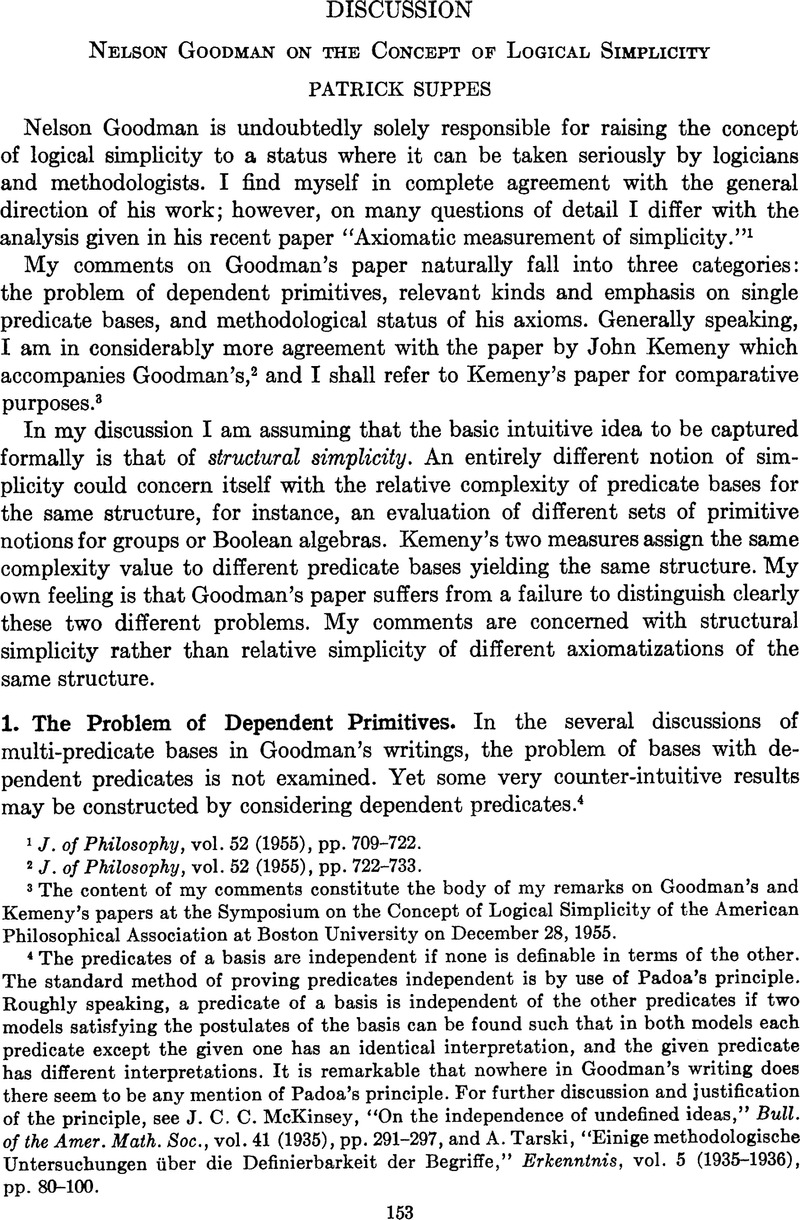Article contents
Nelson Goodman on the Concept of Logical Simplicity
Published online by Cambridge University Press: 14 March 2022
Abstract

- Type
- Discussion
- Information
- Copyright
- Copyright © 1956, The Williams & Wilkins Company
References
1 J. of Philosophy, vol. 52 (1955), pp. 709–722.
2 J. of Philosophy, vol. 52 (1955), pp. 722–733.
3 The content of my comments constitute the body of my remarks on Goodman's and Kemeny's papers at the Symposium on the Concept of Logical Simplicity of the American Philosophical Association at Boston University on December 28, 1955.
4 The predicates of a basis are independent if none is definable in terms of the other. The standard method of proving predicates independent is by use of Padoa's principle. Roughly speaking, a predicate of a basis is independent of the other predicates if two models satisfying the postulates of the basis can be found such that in both models each predicate except the given one has an identical interpretation, and the given predicate has different interpretations. It is remarkable that nowhere in Goodman's writing does there seem to be any mention of Padoa's principle. For further discussion and justification of the principle, see J. C. C. McKinsey, “On the independence of undefined ideas,” Bull. of the Amer. Math. Soc., vol. 41 (1935), pp. 291–297, and A. Tarski, “Einige methodologische Untersuchungen über die Definierbarkeit der Begriffe,” Erkenntnis, vol. 5 (1935–1936), pp. 80–100.
5 See A. Tarski, “A general theorem concerning the reduction of primitive notions,” (Abstract), Journal of Symbolic Logic, vol. 19 (1954), pp. 158–159. I am indebted to Leon Henkin for this reference. The precise definition of a universal pair predicate ‘C’ is:
6 Even the emphasis within single predicate bases seems distorted. Certainly one of the most important properties for classifying ternary predicates is that of designating a binary operation, which is not mentioned by Goodman.
Goodman's Postulate P3 is quoted below, and P4 is an extension of P3.
7 An elaboration of the general viewpoint I am adopting here is to be found in my article “Some remarks on problems and methods in the philosophy of science,” Philosophy of Science, vol. 21 (1954), pp. 242–248.
8 If a formalized language were being used, such as is envisaged for the predicate bases whose simplicity Goodman studies, then it would be natural to speak of a one-place predicate ‘G’ and a two-place functor ‘∗’
9 It should be clear that these criticisms of Goodman's P5 do not apply to Kemeny's two measures, for Kemeny does not attempt an axiomatic analysis, but only proposes two particular measures. As a matter of fact, the desired properties of Kemeny's two measures would be preserved by any similarity transformation.
10 Statements and proofs of such a pair of theorems for axiomatizations of different branches of the theory of measurement are to be found in my article, “A set of independent axioms for extensive quantities,” Portugaliae Mathematica, vol. 10 (1951), pp. 163–172, and my joint article with Muriel Winet, “An axiomatization of utility based on the notion of utility differences,” Management Science, vol. 1 (1955), pp. 259–270.
11 I am a little uneasy with both Goodman's and Kemeny's definitions of predicate bases. The formulation just stated attempts to be a little more precise.
12 The simple notation used in the axioms should be familiar. Thus, Λ is the empty set; P1 ∩ P2 is the intersection of the sets P1 and P2, that is, the set of all predicates common to P1 and P2; P1 ∪ P2 is the union of P1 and P2, that is, the set of all predicates which are either in P1 or in P2.
13 The openness of this problem follows from the openness of a corresponding problem in the theory of subjective probability. The problem was first posed by de Finetti. For a discussion, see L. J. Savage, Foundations of Statistics, New York, 1954, Chapter 3.
- 3
- Cited by


